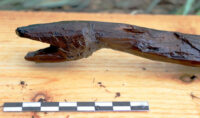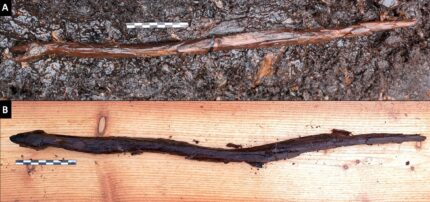A wooden staff carved in the shape of a snake has been discovered at the prehistoric site near the town of Järvensuo in southwest Finland. Radiocarbon dating of the wood found it was made in the Late Neolithic, ca. 2471-2291 B.C. The find is unique on the archaeological record; the closest comparable artifact in design and date is a small clay figurine found 60 miles away in the 1960s.
The Järvensuo 1 site was first discovered accidentally by a ditch-digger in the 1950s by the southern shore of Rautajärvi Lake. The initial find of a wooden paddle, radiocarbon dated to 3331–2462 B.C., was followed decades later by other prehistoric finds, including a scoop with handle carved in the shape of a bear head, preserved in the waterlogged soil. Most of Finland has highly acidic soil that makes short shrift of organic remains, so its wetlands, under active threat by drainage and peat mining, are of priceless archaeological resource.
New excavations began in 2020, 35 years after the last ones, and the digs have revealed a stratigraphy stretching back 5,000 years, including phases of human activity. The wooden snake was unearthed last summer. It was found lying on its right side in a layer of peat two feet below the surface. It  is 21 inches long and 1.2 inches thick at its widest point. It was carved from a single piece of wood with the head of the serpent at one end, two gentle bends conveying its sinuous body and tapering down to the tip of the tail. Its surface is smooth without ornamentation, but it is artfully designed with a slim neck leading to a raised, flat head with an open mouth.
is 21 inches long and 1.2 inches thick at its widest point. It was carved from a single piece of wood with the head of the serpent at one end, two gentle bends conveying its sinuous body and tapering down to the tip of the tail. Its surface is smooth without ornamentation, but it is artfully designed with a slim neck leading to a raised, flat head with an open mouth.
While snakes are not a common theme in the Neolithic art of North Europe, there are some rock carvings and paintings that depict snakes, including one with its mouth open. At least two prehistoric rock paintings in Finland feature a man holding aloft a curvaceous staff reminiscent of the Järvensuo piece.
Ancient rock art from Finland and northern Russia shows human figures with what look like snakes in their hands, which are thought to be portrayals of shamans wielding ritual staffs of wood carved to look like snakes. [University of Helsinki archaeologist Antti] Lahelma said snakes were regarded as especially sacred in the region.
“There seems to be a certain connection between snakes and people,” Lahelma told Antiquity. “This brings to mind northern shamanism of the historical period, where snakes had a special role as spirit-helper animals of the shaman … Even though the time gap is immense, the possibility of some kind of continuity is tantalizing: Do we have a Stone Age shaman’s staff?”
The snake staff has been published in the journal Antiquity and can be read in its entirety here.
